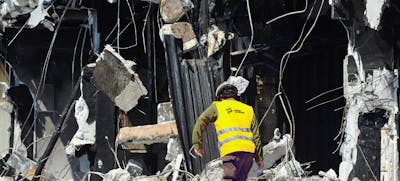Walter P Moore helps clients with disaster response, offering expert insights on addressing hail damage effectively. Partner with us to safeguard your property.
Key Takeaways
- Hail impacts can cause significant damage
- Hail forms vary in size and density
- Documenting hail damage for future resilience is crucial
Overview
Discover the impact of hail damage and the crucial need for timely assessments with expert insights from Walter P Moore. Learn about the importance of post-hail evaluations conducted by qualified engineers and how our innovative approach can help safeguard your property effectively.
The Rising Impact of Hail Damage
Hail is often underestimated compared to other disasters such as tornadoes or hurricanes. Still, it caused more damage in the U.S. last year than tornadoes and straight-line winds combined. In June 2023, hailstorms in the Dallas-Fort Worth area resulted in an estimated $6 to $9 billion in damages. In addition to its damage effect, assessing property for hail damage requires a strong understanding of hail formation and material behavior.
According to the National Weather Service, in 2023 there were 6,962 reported hail events in the U.S., up from 4,436 events in 2022. Severe convective storms, which can produce hail, resulted in $60 billion in losses in 2023, up from $31 billion in 2022. It is expected that hail events and subsequent losses will continue to increase in 2024 and beyond.

Factors and Effects on Buildings
Hail forms when raindrops are carried upward within thunderstorm updrafts, colliding with liquid water droplets and growing in size as they freeze. Hailstones can range in size from small peas to large softballs or grapefruits. The size and density of the hail directly affect the extent of damage to a property. The characteristics of hail and the affected building materials influence the extent of damage experienced. Densely formed hailstones, which will appear visually clear, cause more damage than similarly sized, cloudy formation hailstones. The cloudy formation, being a mixture of air and ice, has less energy upon impact. The damage from hail impacts also varies depending on the building materials. For instance, a roof membrane with a high-density cover board will respond differently than one over a softer insulation layer. The softer the underlying layer, the greater the likelihood of damage to the membrane.
For forensic and diagnostic engineers, documenting the exterior of a building following a hail event is crucial for assessing the impact of hail, addressing damage promptly, and mitigating water intrusion. Timely and thorough assessments are essential for effective repair and maintenance strategies to ensure the resilience and longevity of the structure.
Expertise in Hail Damage Assessment
Hailstone impacts can cause significant damage to building roofs, cladding/siding, metal components, and windows, leading to water intrusion. This damage typically presents as circular or rounded blemishes, fractures, bruises, or indentations, and even penetrations through building components in severe cases.
Assessing hail damage requires expertise, as a thorough understanding of hail is essential to accurately distinguishing hail strike damage from other types. Without this knowledge other damage can be falsely identified as hail-related, or actual hail strike damage might go unnoticed. At Walter P Moore, we combine in-house training with our building envelope and structural engineering expertise to accurately identify hail impact damage and provide appropriate repair recommendations. While assessing a roof for hail damage we often identify other forms of deterioration that can be detrimental to the building’s roofing or cause leaks.
Ensuring Property Resilience
Recently, Walter P Moore performed a hail damage assessment and observed spatter marks indicative of hail impacts on the roof membrane. The damage was localized to the roof seams and areas with ponded water, which are more prone to hailstone impact due to brittleness. Our assessment determined that the damage was localized, recommending partial roof repairs. This approach led to effective repair and minimized unnecessary work, addressing water intrusion effectively.
The increasing frequency and severity of hailstorms pose a year-round risk to properties nationwide. Property owners, managers, and insurers should engage qualified engineers to perform post-hail event assessments. At Walter P Moore, we specialize in building performance, enabling us to provide timely evaluations, generate reliable reports, streamline the claims process, and design effective repairs, retrofits, and reinforcements for roofing, cladding, and glazing components. Walter P Moore is at the forefront of innovation, utilizing drone assessments and AI recognition technology to enhance damage detection and assessments.



